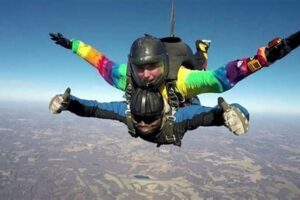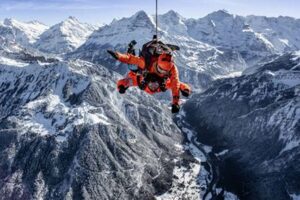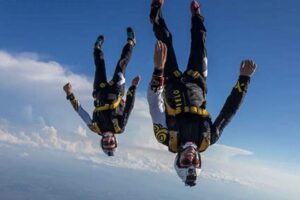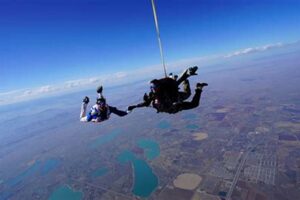Table of Contents
Average Skydive Height: Unveiling the Thrilling Leap from Above
In the realm of adrenaline-fueled adventures, skydiving stands tall, offering a breathtaking plunge from the heavens. At the heart of this exhilarating experience lies the “average skydive height,” a crucial factor that sets the stage for an unforgettable descent. Typically measured from the aircraft’s exit point to the ground, average skydive height ranges from 10,000 to 13,000 feet (3,000 to 4,000 meters). Imagine the exhilaration of freefalling through the vast expanse of sky, surrounded by breathtaking panoramas that stretch as far as the eye can see.
The significance of average skydive height extends beyond its role as a mere measurement. It serves as a key determinant of the skydiving experience, influencing factors such as freefall time, canopy deployment altitude, and overall thrill level. Moreover, it plays a crucial role in ensuring safety, as higher jump altitudes allow for ample time for canopy deployment and maneuvering. Historically, advancements in skydiving equipment and techniques have enabled jumpers to push the boundaries of average skydive height, leading to record-breaking jumps from stratospheric altitudes.
As we delve deeper into the world of skydiving, we will explore the captivating aspects that make this activity so alluring. From the rush of adrenaline to the stunning vistas that unfold during the descent, we will uncover the factors that contribute to the allure of skydiving and delve into the safety measures that ensure a thrilling yet controlled experience. Get ready to soar through the skies as we unravel the secrets of average skydive height and embark on a journey into the realm of this exhilarating sport.
Average Skydive Height
Average skydive height plays a pivotal role in shaping the skydiving experience, influencing factors such as freefall time, canopy deployment altitude, and overall thrill level. Understanding its essential aspects is crucial for both experienced skydivers and those considering taking the leap for the first time.
- Altitude: Measured from the aircraft’s exit point to the ground, typically ranging from 10,000 to 13,000 feet.
- Freefall Time: The duration of the freefall, influenced by the exit altitude and the jumper’s body position.
- Canopy Deployment Altitude: The altitude at which the skydiver deploys their parachute, typically around 5,000 feet.
- Thrill Level: Higher altitudes generally lead to a more intense and exhilarating experience.
- Safety: Higher jump altitudes allow for more time for canopy deployment and maneuvering, enhancing safety.
- Experience Level: Beginner skydivers typically start with lower altitudes, while experienced jumpers may opt for higher jumps.
- Equipment: Specialized skydiving equipment, including parachutes and altimeters, is essential for safe and controlled jumps.
- Weather Conditions: Wind speed, cloud cover, and visibility can impact the choice of jump altitude.
These aspects are interconnected and influence each other. For instance, a higher jump altitude typically results in a longer freefall time, which can be exhilarating for experienced skydivers seeking an adrenaline rush. However, it also requires more time for canopy deployment, which is crucial for a safe landing. Understanding these aspects allows skydivers to make informed decisions about their jump altitude, ensuring a thrilling yet controlled experience.
Altitude
Within the realm of skydiving, altitude reigns supreme as a defining factor that shapes the experience. Measured from the aircraft’s exit point to the ground, average skydive height typically ranges from 10,000 to 13,000 feet, directly influencing the intensity and duration of the freefall, as well as the overall safety of the jump. Delving into the intricacies of altitude, we uncover its multifaceted nature and the profound impact it has on the skydiving adventure.
- Height Variations: Skydive heights are not set in stone but rather tailored to the experience level, preferences, and local regulations. Beginner skydivers often commence their journey with lower altitudes, gradually ascending to greater heights as they gain proficiency.
- Freefall Time: Altitude plays a pivotal role in determining the duration of the freefall, the exhilarating phase of the skydive where jumpers experience the rush of plummeting towards the earth. Higher altitudes translate to longer freefall times, offering more time to soak in the breathtaking panorama.
- Canopy Deployment: The altitude at which skydivers deploy their parachutes is meticulously calculated, typically around 5,000 feet. This crucial decision is influenced by factors such as altitude, wind speed, and the jumper’s experience level, ensuring a safe and controlled descent.
- Thrill Factor: Altitude directly correlates with the intensity of the skydiving experience. Higher altitudes amplify the sensation of freefall, providing a more pronounced adrenaline rush for thrill-seekers.
In essence, altitude stands as a cornerstone of the skydiving experience, influencing the freefall time, canopy deployment, and overall thrill level. Understanding its significance empowers skydivers to make informed decisions about their jump altitude, ensuring an adventure that aligns with their skill level and desired level of exhilaration.
Freefall Time
Within the exhilarating realm of skydiving, freefall time stands as a pivotal aspect that intertwines with average skydive height, shaping the overall experience. Measured from the moment of exiting the aircraft until the deployment of the parachute, freefall time offers a thrilling descent through the vast expanse of the sky.
- Altitude Influence: Higher jump altitudes directly correlate with extended freefall durations. This allows jumpers to relish in the exhilarating sensation of plummeting for an extended period, amplifying the adrenaline rush.
- Body Position: Skydivers can manipulate their body position to influence their freefall speed and duration. Streamlined positions, resembling a pencil or an arrow, minimize air resistance and promote faster descents, while spread-eagle positions create more drag, slowing the fall.
- Skill and Experience: As skydivers progress in skill and experience, they gain the ability to control their body position and trajectory more effectively, enabling them to extend their freefall time and perform intricate maneuvers.
- Equipment: Specialized skydiving suits and gear can also influence freefall time. Wingsuits, for instance, provide jumpers with additional lift and maneuverability, allowing them to soar through the air and prolong their freefall experience.
In essence, freefall time emerges as a dynamic aspect of skydiving, intricately linked to average skydive height and influenced by the jumper’s body position, skill level, and equipment choices. Understanding these factors empowers skydivers to tailor their freefall experience, whether seeking an adrenaline-fueled rush or a more controlled and extended descent.
Canopy Deployment Altitude
In the realm of skydiving, canopy deployment altitude holds a critical co
nnection with average skydive height, influencing both the safety and exhilaration of the experience.
Cause and Effect: The choice of canopy deployment altitude is directly affected by average skydive height. Higher jump altitudes necessitate higher deployment altitudes to allow sufficient time for the parachute to fully open and stabilize before reaching the ground. Conversely, lower jump altitudes require lower deployment altitudes to avoid the risk of impacting the ground before the parachute has fully deployed.
Importance as a Component: Canopy deployment altitude serves as a crucial component of average skydive height, as it directly impacts the overall safety and success of the jump. Deploying the parachute at the appropriate altitude ensures a controlled and safe descent, allowing the skydiver to land safely while maintaining a thrilling experience.
Real-Life Examples: In typical skydiving scenarios, canopy deployment altitudes generally range from 5,000 to 7,000 feet above ground level. This altitude provides ample time for the parachute to fully deploy and stabilize, giving the skydiver sufficient time to maneuver and prepare for landing. However, in high-altitude skydives, such as those performed for record-breaking attempts, deployment altitudes can reach up to 10,000 feet or higher, necessitating specialized equipment and extensive training.
Practical Applications: Understanding the connection between canopy deployment altitude and average skydive height is essential for ensuring safety and maximizing enjoyment during a skydiving experience. It enables skydivers to make informed decisions about their jump altitude and deployment altitude based on their skill level, experience, and the prevailing weather conditions. Proper training and practice are crucial in developing the judgment and skills necessary to select the appropriate deployment altitude for a given skydive.
In essence, canopy deployment altitude and average skydive height are inextricably linked, with each influencing the other to create a thrilling yet controlled skydiving experience. Understanding this relationship is paramount for ensuring safety and maximizing enjoyment during a skydive.
Thrill Level
In the realm of skydiving, the thrill level is an integral aspect that is directly influenced by the average skydive height. Higher altitudes offer a more intense and exhilarating experience due to several key factors:
- Extended Freefall: Higher jump altitudes result in longer freefall durations, providing skydivers with an extended period of unadulterated freefall, amplifying the sensation of plummeting through the sky.
- Increased Speed: As skydivers descend from higher altitudes, they experience greater speeds due to the increased distance and acceleration, intensifying the physical and emotional exhilaration.
- Heightened Sensory Stimulation: The panoramic views from higher altitudes are breathtaking, offering skydivers a vast and awe-inspiring perspective of the surrounding landscape, enhancing the overall sensory experience.
- Greater Challenge: Higher altitude skydives demand more skill, precision, and mental fortitude, adding an element of challenge that further elevates the thrill level for experienced skydivers.
The relationship between average skydive height and thrill level is undeniable. As skydivers ascend to greater heights, they unlock a realm of heightened exhilaration and adventure, pushing the boundaries of their physical and mental capabilities. Whether seeking an adrenaline rush or a transformative experience, higher altitude skydives offer an unparalleled thrill that caters to the most intrepid adventurers.
Safety
In the realm of skydiving, safety is paramount. Higher jump altitudes play a crucial role in enhancing safety by providing more time for canopy deployment and maneuvering. This intricate connection is multifaceted and demands a thorough exploration.
Cause and Effect: The relationship between higher jump altitudes and enhanced safety is rooted in physics and practical considerations. As skydivers ascend to greater heights, they gain the advantage of extended freefall time. This extended duration allows for more time to deploy the parachute, ensuring its proper inflation and stabilization before reaching the ground. Additionally, higher altitudes provide skydivers with ample time to assess their surroundings, adjust their body position, and perform necessary maneuvers to ensure a safe and controlled landing.
Critical Component: Canopy deployment altitude serves as a critical component of average skydive height. It is intricately linked to safety, as deploying the parachute at an appropriate altitude is crucial for a successful and controlled descent. Higher jump altitudes allow skydivers to choose a higher deployment altitude, providing a greater margin of safety and reducing the risk of malfunctions or complications during the deployment process.
Real-Life Examples: The importance of higher jump altitudes for safety is evident in various real-life scenarios. In cases of equipment malfunctions or entanglement, having more time and altitude allows skydivers to troubleshoot and take corrective actions, increasing their chances of a safe landing. Furthermore, higher altitudes provide a buffer zone in case of wind shifts or sudden changes in weather conditions, giving skydivers more time to react and adjust their flight path accordingly.
Practical Applications: Understanding the connection between higher jump altitudes and enhanced safety has several practical implications. It guides skydiving regulations and training protocols, emphasizing the importance of proper altitude selection and canopy deployment procedures. Additionally, it informs the design and development of skydiving equipment, such as parachutes and altimeters, to ensure maximum safety and reliability at various altitudes.
Conclusion: In summary, the connection between higher jump altitudes and enhanced safety in skydiving is undeniable. Higher altitudes provide more time for canopy deployment and maneuvering, allowing skydivers to mitigate risks and increase the likelihood of a safe and successful landing. This understanding serves as a cornerstone for safety protocols, training programs, and equipment development in the world of skydiving.
Experience Level
Within the realm of skydiving, experience level plays a pivotal role in determining average skydive height. Understanding this relationship is crucial for ensuring safety, maximizing enjoyment, and fostering a sense of progression in the sport.
- Gradual Progression: Beginner skydivers typically start with lower altitudes, gradually ascending to greater heights as they gain experience and proficiency. This measured approach allows them to build confidence, master basic skills, and develop the necessary judgment for higher jumps.
- Safety Considerations: Higher altitudes require more time for canopy deployment and maneuvering, which can be challenging for beginners. Starting with lower altitudes minimizes risks and allows skydivers to focus on developing fundamental skills without being overwhelmed by the added complexity of higher jumps.
- Skill Development: As skydivers progress in experience, they develop better control over their body position and trajectory, enabling them to maintain stability and perform intricate maneuvers during freefall. This proficiency allows them to safely execute jumps from higher altitudes, where the extended freefall time provides ample opportunities for skill demonstration.
- Thrill Seeking: Experienced skydivers often seek the exhilarating rush of higher altitude jumps. The increased speed, longer freefall duration, and breathtaking view
s from greater heights offer an amplified sensory experience that caters to their adventurous spirit.
In summary, the relationship between experience level and average skydive height is multifaceted. Beginner skydivers start with lower altitudes for safety and skill development, while experienced jumpers opt for higher jumps to enhance their thrill and showcase their mastery of the sport. Understanding this dynamic is essential for skydivers to progress safely and enjoyably through the various stages of their skydiving journey.
Equipment
In the realm of skydiving, specialized equipment plays a pivotal role in ensuring the safety and success of every jump. This connection between equipment and average skydive height is multifaceted and demands a thorough exploration.
Cause and Effect: The relationship between specialized skydiving equipment and average skydive height is one of cause and effect. The type and quality of equipment used directly influence the safety and control of a skydive, particularly at higher altitudes. For instance, parachutes designed for high-altitude jumps are equipped with larger canopies, allowing for more stability and control during freefall and deployment. Similarly, altimeters are crucial for accurately measuring altitude and triggering the parachute deployment at the appropriate height, especially when jumping from greater heights.
Critical Component: Specialized skydiving equipment serves as a critical component of average skydive height, enabling skydivers to safely execute jumps from various altitudes. Without appropriate equipment, such as a properly fitted parachute and a reliable altimeter, venturing into higher altitudes would be extremely hazardous. This equipment provides skydivers with the necessary control and safety measures to confidently navigate the challenges of high-altitude skydives.
Real-Life Examples: Numerous real-life examples underscore the importance of specialized equipment in high-altitude skydiving. Professional skydivers often rely on custom-designed parachutes and advanced altimeters to ensure safety and performance during record-breaking jumps from extreme altitudes. These specialized pieces of equipment allow them to maintain stability, control their descent, and deploy their parachutes accurately, even in challenging conditions.
Practical Applications: Understanding the connection between specialized equipment and average skydive height has several practical applications. It guides equipment manufacturers in developing and innovating new technologies to enhance safety and performance at various altitudes. Additionally, it informs skydiving regulations and training protocols, emphasizing the importance of proper equipment selection, maintenance, and usage. This understanding also empowers skydivers to make informed decisions about the equipment they use, ensuring it matches their skill level and the demands of the intended jump.
Conclusion: In summary, the relationship between specialized skydiving equipment and average skydive height is inseparable. Specialized equipment serves as a critical component, enabling skydivers to safely and effectively execute jumps from varying altitudes. Understanding this connection is essential for manufacturers, regulators, skydivers, and anyone involved in the sport to ensure the continued safety and enjoyment of skydiving.
Weather Conditions
In the realm of skydiving, weather conditions play a pivotal role in determining the choice of average skydive height, as they directly influence the safety, feasibility, and overall experience of the jump. Understanding this relationship is crucial for skydivers to make informed decisions and ensure a successful and enjoyable skydiving adventure.
Cause and Effect: The connection between weather conditions and average skydive height is one of cause and effect. Adverse weather conditions can significantly impact the safety and control of a skydive, particularly at higher altitudes. Strong winds can affect the trajectory and stability of the skydiver during freefall, making it more challenging to maintain control and land safely. Cloud cover can reduce visibility, making it difficult for skydivers to navigate and locate the drop zone accurately. Poor visibility can also hinder the deployment of the parachute at the appropriate altitude, increasing the risk of complications.
Critical Component: Weather conditions serve as a critical component of average skydive height, as they dictate the safety and feasibility of the jump. Skydiving operators and experienced skydivers carefully assess weather conditions before making decisions about jump altitudes and procedures. In cases of inclement weather, such as severe winds or heavy cloud cover, skydives may be postponed or canceled to ensure the safety of the participants.
Real-Life Examples: Numerous real-life examples underscore the importance of considering weather conditions when determining average skydive height. In high-altitude skydives, strong winds can cause significant deviations from the intended flight path, potentially leading to dangerous situations. Similarly, poor visibility due to cloud cover can make it difficult for skydivers to locate the drop zone and may necessitate lower jump altitudes to ensure a safe landing.
Practical Applications: Understanding the connection between weather conditions and average skydive height has several practical applications. It guides skydiving regulations and training protocols, emphasizing the importance of weather monitoring and decision-making. Additionally, it informs the development of skydiving equipment, such as specialized parachutes and altimeters, to enhance safety and performance in various weather conditions. This understanding also empowers skydivers to make informed choices about their jump altitude and timing, ensuring they align with the prevailing weather conditions.
Conclusion: In summary, weather conditions play a crucial role in determining average skydive height, as they directly impact the safety, feasibility, and overall experience of the jump. Understanding this relationship is essential for skydivers to make informed decisions, mitigate risks, and enjoy a successful and memorable skydiving adventure.
Frequently Asked Questions
This section addresses frequently asked questions and clarifies common misconceptions related to average skydive height. These questions aim to provide a comprehensive understanding of the factors that influence jump altitude and its implications for skydivers.
Question 1: What is the typical range for average skydive height?
Answer: Average skydive height generally ranges from 10,000 to 13,000 feet (3,000 to 4,000 meters), although it can vary depending on factors such as experience level, weather conditions, and local regulations.
Question 2: How does altitude affect the skydiving experience?
Answer: Altitude significantly influences the duration of freefall, the thrill level, and the safety considerations of a skydive. Higher altitudes result in longer freefall times, more intense adrenaline rushes, and a greater need for careful planning and equipment checks.
Question 3: What is the relationship between altitude and freefall time?
Answer: Altitude directly correlates with freefall time. Higher jump altitudes allow for longer freefall durations, providing skydivers with an extended period of unadulterated freefall and a more amplified sense of exhilaration.
Question 4: How does altitude impact safety during a skydive?
Answer: Higher altitudes provide more time for canopy deployment and maneuvering, enhancing overall safety. This extend
ed time allows skydivers to assess their surroundings, adjust their body position, and perform necessary maneuvers to ensure a safe and controlled landing.
Question 5: How is altitude determined for a specific skydive?
Answer: The choice of jump altitude is influenced by various factors, including weather conditions, the experience level of the skydiver, and the type of skydiving being performed. Skydiving operators and experienced skydivers carefully consider these factors to determine the most appropriate altitude for each jump.
Question 6: Can skydivers choose their jump altitude?
Answer: While skydivers may have preferences for jump altitude, the ultimate decision is typically made in consultation with the skydiving operator and is subject to safety considerations, weather conditions, and regulations.
These FAQs provide valuable insights into the concept of average skydive height, its impact on the skydiving experience, and the factors that influence altitude selection. Understanding these aspects is crucial for skydivers to make informed decisions and ensure a safe and enjoyable skydiving adventure.
The next section of our article will delve into the technical considerations and safety measures associated with high-altitude skydives, providing further guidance for experienced skydivers seeking to push the boundaries of this exhilarating sport.
Tips for a Thrilling and Safe Skydiving Experience
In this section, we present expert tips to enhance your skydiving adventure, ensuring both an exhilarating and safe experience. Whether you’re a seasoned skydiver or preparing for your first jump, these tips will help you make the most of your skydive.
Tip 1: Choose a Reputable Skydiving Operator:
Conduct thorough research to select a skydiving operator with an impeccable safety record and experienced instructors. Their expertise and professionalism will contribute to a smooth and enjoyable skydive.
Tip 2: Follow Pre-Jump Instructions Carefully:
Pay close attention to the pre-jump briefing and instructions provided by your skydiving instructor. These instructions cover essential safety procedures, body positions, and emergency protocols. Following them diligently is paramount for a successful and safe jump.
Tip 3: Master Proper Body Positioning:
Learn and practice the correct body positioning techniques for freefall and canopy flight. Maintaining a stable body position ensures better control, enhances safety, and maximizes your enjoyment of the skydive.
Tip 4: Communicate Effectively with Your Tandem Instructor:
If you’re participating in a tandem skydive, open communication with your instructor is crucial. Clearly express your concerns, questions, and preferences to ensure a seamless and enjoyable experience.
Tip 5: Stay Calm and Breathe Deeply:
It’s natural to feel a surge of adrenaline before your jump. Embrace this excitement, but remember to stay calm and focused. Deep breathing techniques can help manage anxiety and maintain a clear mind throughout the skydive.
Tip 6: Savor Every Moment:
From the breathtaking views during the ascent to the exhilarating rush of freefall, every moment of a skydive is unique. Stay present, soak in the experience, and create lasting memories.
Tip 7: Trust Your Equipment and Instructors:
Skydiving equipment undergoes rigorous inspections and maintenance to ensure safety. Trust the quality of your gear and the expertise of your instructors. This confidence will allow you to fully embrace the thrill of the experience.
Tip 8: Consider Video and Photo Options:
Capture the memories of your skydive with professional video and photography services offered by many skydiving operators. These recordings provide a tangible way to relive and share the excitement of your jump with family and friends.
By following these tips, you can elevate your skydiving experience, ensuring maximum enjoyment and safety. In the concluding section of this article, we’ll explore the incredible benefits of skydiving, from the adrenaline rush to the profound personal growth it can foster.
Conclusion
Our exploration of “average skydive height” reveals a multifaceted concept that encompasses safety, exhilaration, and personal growth. Key findings include the direct correlation between altitude and freefall time, the enhanced safety measures provided by higher altitudes, and the influence of weather conditions and equipment on jump altitude selection.
Firstly, altitude significantly influences the skydiving experience. Higher altitudes result in longer freefall durations, amplifying the adrenaline rush and providing more time for maneuvers. However, these higher altitudes also demand more time for canopy deployment and maneuvering, highlighting the crucial role of safety considerations.
Secondly, weather conditions and specialized equipment play pivotal roles in determining jump altitude. Adverse weather conditions can impact the safety and feasibility of a skydive, while appropriate equipment ensures control and stability at various altitudes.
In conclusion, average skydive height is not merely a numerical value but a carefully considered factor that balances the thrill of the jump with safety measures and environmental conditions. Understanding the intricacies of average skydive height empowers skydivers to make informed decisions, ensuring an exhilarating and unforgettable skydiving experience.







